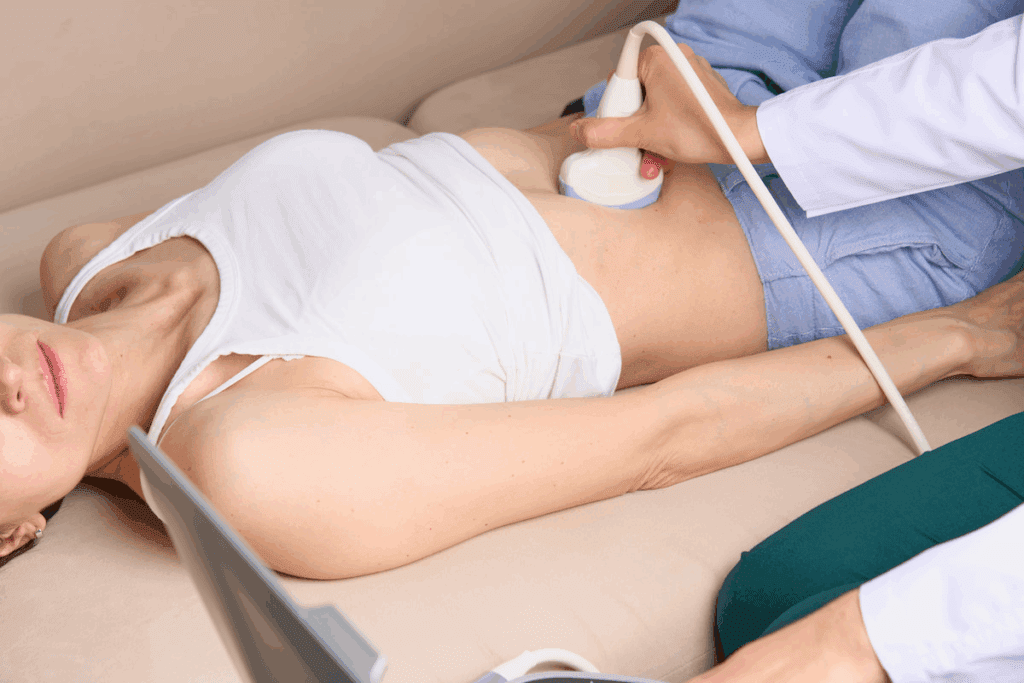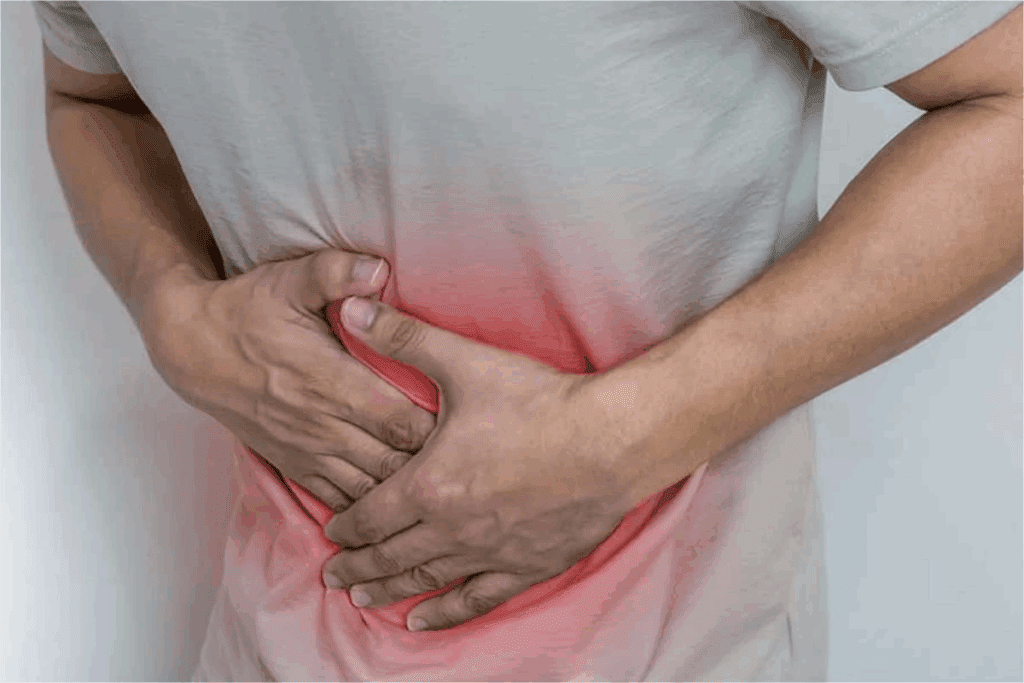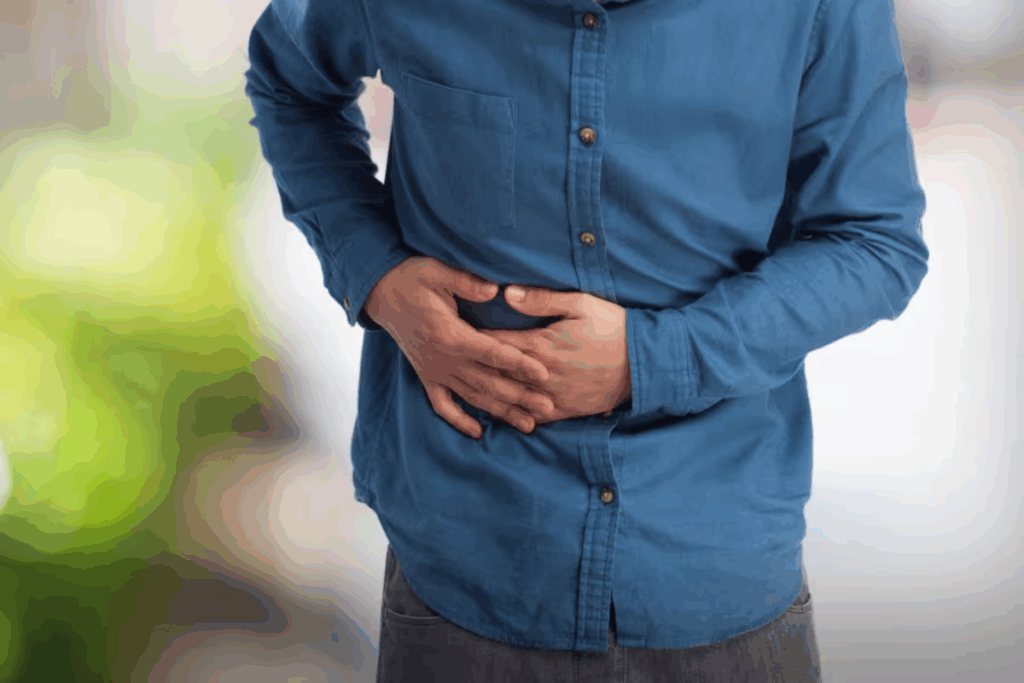Last Updated on November 26, 2025 by Bilal Hasdemir

The gallbladder is a small organ that stores bile from the liver. It releases bile during digestion to help break down fats. A contracted gallbladder means this organ has shrunk a lot. This usually happens because of chronic inflammation or gallstone disease. Understand gallbladder collapsed meaning, causes, and whether this condition is dangerous.
Knowing about a contracted gallbladder is key for getting the right treatment. At Liv Hospital, we focus on patient trust and high standards. We use advanced diagnostics and care with compassion.

The gallbladder is a pear-shaped organ that stores bile. Bile is a fluid that helps break down fats during digestion. It is located under the liver on the right side of the abdomen. It is key to the digestive system.
The gallbladder is small, storing about 50 milliliters of bile. It is made to store and concentrate bile from the liver. It has parts like the fundus, body, and neck, which connect to the cystic duct.
The gallbladder’s wall has three layers: mucosa, muscularis, and serosa. The mucosa lines the inside, the muscularis contracts to release bile, and the serosa is the outer layer.
Bile is vital for digesting fats and fat-soluble vitamins. It breaks down fats into smaller pieces for enzymes to process. It also helps absorb vitamins A, D, E, and K.
“Bile is a key component in the digestion process, facilitating the breakdown and absorption of fats.”
Bile includes bile salts, cholesterol, bilirubin, and more. Bile salts are key for emulsifying fats, making them easier for enzymes to break down.
| Component | Function |
| Bile Salts | Emulsify fats |
| Cholesterol | Precursor to bile salts |
| Bilirubin | Breakdown product of hemoglobin |
The gallbladder contracts due to hormonal signals, mainly cholecystokinin (CCK). This hormone is released by the duodenum when fatty foods are present. This contraction releases bile into the cystic duct, then into the common bile duct and into the small intestine.
The process is highly regulated to ensure bile is released when needed for fat digestion. This contraction and release are key for nutrient absorption.
In summary, the gallbladder is essential for digestion by storing and releasing bile. Knowing its anatomy and function helps us understand its importance for health and the effects of dysfunction.

A contracted gallbladder is when the gallbladder shrinks due to disease. This usually happens because of long-term inflammation, scarring, or fibrosis. These changes can come from different diseases.
A contracted gallbladder is smaller and doesn’t work well. Doctors call it a condition where the gallbladder shrinks and stops working because of chronic disease. They might say it’s due to “chronic cholecystitis” or “fibrosis of the gallbladder.”
Key aspects of a contracted gallbladder include:
It’s important to know the difference between normal and abnormal gallbladder contraction. Normal contraction happens after eating fatty foods, helping with digestion. But, abnormal contraction is when the gallbladder stays contracted because of disease, leading to its reduced size and function.
“The gallbladder’s ability to contract and release bile is key for digestion. When it’s affected by disease, it can cause digestive problems.”
A partially contracted gallbladder might work a bit, but a fully contracted one doesn’t work at all. Knowing the difference helps doctors decide the best treatment.
| Characteristics | Partially Contracted | Fully Contracted |
| Gallbladder Function | Some residual function | Non-functional |
| Size | Reduced but visible | Significantly shrunken |
| Symptoms | May vary | Often more severe |
The number of people with a contracted gallbladder varies. It depends on who is studied and why. Risk factors include chronic gallstone disease, recurrent cholecystitis, and metabolic disorders. Knowing these risks helps catch and manage the problem early.
A contracted gallbladder might mean there’s an underlying disease. Not all cases show symptoms, but when they do, it’s often sharp pain in the upper right abdomen. Early diagnosis and treatment are key to avoiding worse problems.
Knowing why a gallbladder contracts is key to treating it. Many conditions can affect how well a gallbladder works and its shape.
Chronic inflammation is a big reason for a contracted gallbladder. Chronic inflammation can make the gallbladder wall thick and scarred. This leads to it shrinking.
“Chronic inflammation can lead to fibrosis and scarring, which are key factors in the development of a contracted gallbladder.” – A medical expert on gallbladder diseases.
Gallstones are another common reason for a contracted gallbladder. Gallstones can block bile ducts, causing inflammation and scarring. This can make the gallbladder contract over time.
| Cause | Effect on Gallbladder |
| Gallstones | Obstruction, inflammation, scarring |
| Chronic Inflammation | Scarring, thickening, contraction |
| Cholecystitis | Inflammation, scarring, contraction |
Cholecystitis, whether sudden or ongoing, can cause a contracted gallbladder. Acute cholecystitis is a sudden inflammation, often from gallstones. Chronic cholecystitis has repeated inflammation, leading to scarring and contraction.
Fibrosis and scarring come from chronic inflammation and cholecystitis. These changes can make the gallbladder contract. Fibrosis is when too much fibrous tissue forms, stiffening and shrinking the gallbladder.
“The fibrosis and scarring associated with chronic gallbladder disease can lead to a contracted gallbladder, significantly impairing its function.”
A gastroenterology textbook
In summary, a contracted gallbladder can be caused by chronic inflammation, gallstone disease, cholecystitis, and the resulting fibrosis and scarring. Knowing these causes is vital for diagnosing and treating the condition.
It’s important to know the signs of a contracted gallbladder to avoid serious problems. This condition can show itself in many ways, some of which are similar to other stomach issues. Knowing these symptoms helps doctors diagnose and treat it right.
Abdominal pain is a common sign of a contracted gallbladder. The pain can be mild or very severe. It usually feels in the upper right part of the stomach and might spread to the right shoulder or back.
Pain Characteristics: The pain can feel sharp, dull, or crampy. It often gets worse after eating fatty foods.
Digestive problems are also common with a contracted gallbladder. These include nausea, vomiting, and changes in how often you go to the bathroom.
In some cases, a contracted gallbladder can cause jaundice. This is when your skin and eyes turn yellow because bile can’t flow into your intestine.
Related symptoms include dark urine and pale stools.
Not everyone with a contracted gallbladder will show symptoms. Sometimes, it’s found by accident during tests for other reasons.
| Symptom | Description |
| Abdominal Pain | Pain in the upper right abdomen, potentially radiating to the shoulder or back |
| Digestive Disturbances | Nausea, vomiting, diarrhea, constipation, bloating |
| Jaundice | Yellowing of the skin and eyes, dark urine, pale stools |
In conclusion, knowing the symptoms of a contracted gallbladder is key for quick diagnosis and treatment. If you’re having ongoing or severe symptoms, see a doctor right away.
To find out if a gallbladder is contracted, doctors use imaging and lab tests. These methods help tell if the gallbladder is just shrinking normally or if there’s a problem.
Ultrasound is the top choice for checking the gallbladder. It looks for gallstones and inflammation. If the gallbladder is contracted, it might look thickened or shrunken on the ultrasound. It might also show gallstones or sludge.
“Ultrasound is very good at finding gallstones and inflammation in the gallbladder,” a study in the Journal of Clinical Gastroenterology says.
A CT scan gives more details about the gallbladder and nearby areas. It’s great for spotting serious issues like gallbladder perforation or gangrene. CT scans can also find other reasons for belly pain.
A HIDA scan checks how well the gallbladder works by tracing bile flow. If the gallbladder is contracted, it might show impaired emptying or not be seen at all. This means it’s not working right.
Labs like liver function tests and complete blood counts help confirm a contracted gallbladder. High liver enzymes or inflammatory markers can point to cholecystitis or other gallbladder problems.
In short, using imaging and lab tests together is key to diagnosing a contracted gallbladder and figuring out why it’s happening.
Not all contracted gallbladders are a big deal right away. But, some can get worse if not treated. This can happen for many reasons, some of which might need careful handling.
The danger of a contracted gallbladder depends on why it happened and if you’re feeling symptoms. Sometimes, it’s found by accident during tests for other things. Other times, it might mean something serious is going on.
Table: Clinical Significance Based on Underlying Causes
| Cause | Clinical Significance | Risk of Complications |
| Chronic Inflammation | High | Increased risk of gallbladder dysfunction |
| Gallstone Disease | Moderate to High | Risk of obstruction and cholecystitis |
| Cholecystitis | High | Risk of severe infection and gangrene |
Some things make complications more likely with a contracted gallbladder. These include having gallstones, chronic inflammation, and past cholecystitis. Spotting these early is key to managing the issue well.
If the gallbladder is not causing symptoms and is found by accident, watching it closely might be okay. This means doing regular tests to see if the gallbladder is changing.
Some symptoms need you to see a doctor right away. These include really bad stomach pain, yellow skin or eyes, and signs of infection like fever. Quick action on these signs can stop serious problems.
In short, not all contracted gallbladders are a big risk. But knowing why it happened and the risks involved helps figure out the best way to handle it.
There are several ways to treat a contracted gallbladder, depending on the cause and how bad it is. Choosing the right treatment is key to managing symptoms and avoiding complications.
For some, starting with conservative management is a good first step. This might include:
Conservative management is often for those with mild symptoms or who can’t have surgery.
Doctors may prescribe medications to help with symptoms. These can include:
It’s important to take the medication as directed and talk to your doctor about any side effects or concerns.
Often, the best treatment is surgical removal of the gallbladder (cholecystectomy). This is usually needed for chronic inflammation or gallstones. Surgery is recommended for those with severe or recurring symptoms.
After treatment, whether it’s conservative or surgery, post-treatment care is critical for recovery. This includes:
Understanding the treatment options and working with a healthcare provider helps patients make informed decisions about their care.
To prevent gallbladder problems, making healthy lifestyle choices is key. This includes changing your diet, exercising regularly, and managing your weight. These steps can greatly lower your risk of gallbladder issues.
Your diet is very important for gallbladder health. Reducing fat intake helps ease the gallbladder’s workload. Foods like salmon and walnuts, which are rich in omega-3 fatty acids, are good choices. Also, eating more fruits, vegetables, and whole grains is beneficial.
Staying active and keeping a healthy weight are key for gallbladder health. Exercise improves bile flow, which helps prevent gallstones. Aim for 150 minutes of moderate exercise each week, like brisk walking, cycling, or swimming.
| Exercise Type | Frequency | Benefits |
| Brisk Walking | 3 times a week | Improves cardiovascular health |
| Cycling | 2 times a week | Enhances muscle strength |
| Swimming | 2 times a week | Supports overall well-being |
It’s important to regularly check in with your healthcare provider if you have gallbladder issues. This means periodic ultrasound checks and visits to your doctor. This helps keep an eye on your condition and quickly address any problems.
The future outlook for gallbladder issues depends on the cause and how well you manage it. With the right lifestyle changes and treatment, many people can live active lives with few problems.
By focusing on prevention and being proactive about gallbladder health, you can greatly improve your life quality.
A contracted gallbladder can really affect a person’s health. It often shows there’s a problem with the gallbladder or another disease. Knowing the causes, symptoms, and how to diagnose it is key to treating it well.
Having a contracted gallbladder might mean you have chronic inflammation or gallstones. Spotting symptoms like stomach pain and digestive issues is important. It helps you get the medical help you need.
Tests like ultrasound and CT scans help find a contracted gallbladder and figure out why. Treatment can be simple or might need surgery, based on how bad it is.
Keeping your gallbladder healthy with the right diet and check-ups can stop problems. Knowing about a contracted gallbladder lets you manage it better. This can make you feel better overall.
In short, a contracted gallbladder needs quick doctor visits to find out why and how to fix it. Taking care of your gallbladder health can lower risks and make life better.
A contracted gallbladder means the gallbladder is smaller than usual. This can happen due to inflammation, gallstones, or other issues. It can make the gallbladder work poorly.
No, a contracted gallbladder is not usually normal. It often means there’s a problem. But, the gallbladder does contract normally after eating to release bile.
Symptoms can include pain in the abdomen, digestive problems, and jaundice. Some people might not show any symptoms at all.
Doctors use tests like ultrasound or CT scans to find out. They also check liver function and bile ducts through lab tests.
Causes include chronic inflammation, gallstones, cholecystitis, and fibrosis. These can cause scarring and make the gallbladder contract.
Treatment depends on the cause. It might include medicine, surgery, or just watching it closely. Sometimes, surgery is needed.
Yes, it can be. It’s a sign of a problem that needs attention. If ignored, it could lead to serious issues like rupture or blockage.
Making healthy lifestyle choices helps. This includes eating right, exercising, and keeping a healthy weight. Always follow up with your doctor.
It means the gallbladder is not fully contracted. This can be a sign of a problem.
It’s the normal process of the gallbladder releasing bile. But, abnormal or constant contraction can mean there’s a problem.
Yes, some people with a contracted gallbladder won’t show symptoms. It’s possible for it to be silent.
Pietrangelo, A. (2024). Managing weight loss after gallbladder removal. Medical News Today. Retrieved from https://www.medicalnewstoday.com/articles/317659
Subscribe to our e-newsletter to stay informed about the latest innovations in the world of health and exclusive offers!